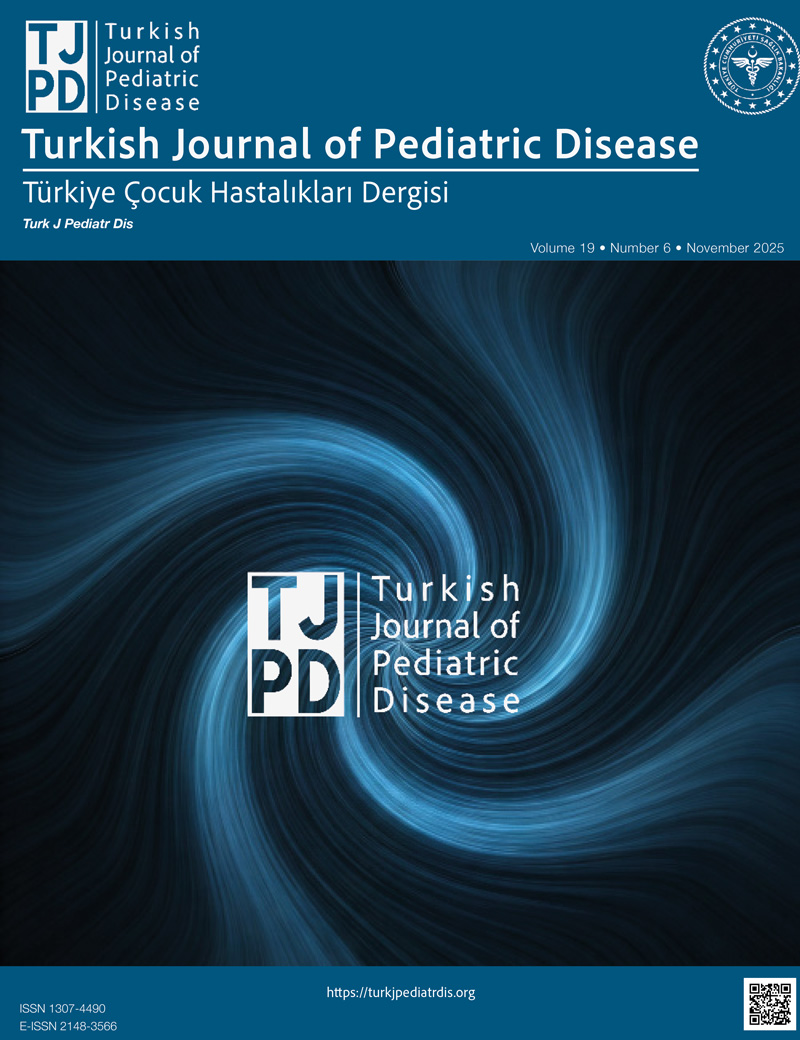Abstract
Objective: This study aimed to evaluate the relationship between mid-upper arm circumference (MUAC) and quality of life in children with cerebral palsy (CP).
Material and Methods: A total of 99 children aged 2–18 years with a diagnosis of CP were included in the study. Nutritional status and quality of life were assessed using anthropometric measurements and the Pediatric Quality of Life Inventory (PedsQL 3.0 CP Module).
Results: This study revealed that mid-upper arm circumference (MUAC) is a reliable indicator not only of nutritional status but also of quality of life in children with cerebral palsy. Anthropometric parameters such as height, weight, MUAC, thigh circumference, and arm length were significantly lower in children with feeding difficulties (p<0.001). MUAC was strongly and positively correlated with total PedsQL scores (r=0.988, p<0.001), indicating a robust association between nutritional status and perceived quality of life. Additionally, as GMFCS level increased, indicating more severe motor impairment, both growth metrics and quality of life scores declined.
Conclusion: MUAC measurement reflects both malnutrition and quality of life in children with CP. Routine clinical use of this parameter in follow-up is recommended.
Keywords: Anthropometry, cerebral palsy, quality of life
References
- Paker N, Yavuz Mollavelioglu T, Bugdaycı D, Ones K, Bardak AN, Karacan I, Yıkıcı I, et al. Vitamin D levels in children with cerebral palsy. J Pediatr Rehabil Med. 2023;16(1):163-169. https://doi.org/10.3233/PRM-190622
- Jahan I, Sultana R, Afroz M, Muhit M, Badawi N, Khandaker G. Dietary intake, feeding pattern, and nutritional status of children with cerebral palsy in rural Bangladesh. Nutrients. 2023;15(19):4209. https://doi.org/10.3390/nu15194209
- Chanie ES, Moges N, Baye FD, Mekonnen GB, Fekadie MM, Bazezew LY, et al. Estimate the burden of malnutrition among children with cerebral palsy in Sub-Saharan Africa: a systematic review with meta-analysis. Sci Rep. 2024;14:6494. https://doi.org/10.1038/s41598-024-55730-1
- Arya V, Khyalia S, Bhalla K. High fiber diet versus polyethylene glycol in management of chronic constipation in children with cerebral palsy: A randomized controlled trial. J Family Med Prim Care. 2024 Sep;13(9):1234-1240. https://doi.org/10.4103/jfmpc.jfmpc_464_24
- Romano C, van Wynckel M, Hulst J, Broekaert I, Bronsky J, Dall’Oglio L, et al. Feeding problems and gastrointestinal disorders in children with cerebral palsy. Medicina (Kaunas). 2016;52(2):63-67.
- Sungurtekin H, Sungurtekin U, Oner O, Okke D. Malnutrition in neurological diseases: impact on clinical outcome. Nutrition. 2004;20(7-8):686-690.
- World Health Organization (WHO). WHO child growth standards: Length/height-for-age, weight-for-age, weight-for-length, weight-for-height and body mass index-for-age: Methods and development. WHO Press. 2006.
- Zhang Y, Li X, Wang Y, Liu Z, Chen H, Zhao J, Wang X, Li J, Zhou Y, Wu J, et al. Prevalence and impact of malnutrition risk on outcomes in critically ill patients with neurological diseases: A multicenter retrospective cohort study. Nutrients. 2023;15(15):2396. https://doi.org/10.3390/nu16152396
- Memik NC, Ağaoğlu B, Coşkun A, Karakaya I. The validity and reliability of the Turkish Pediatric Quality of Life Inventory for children 8-12 years old. Turk Psikiyatri Derg. 2008;19(4):409-417.
- Aydın K, Dalgıç B, Kansu A, Özen H, Selimoğlu MA, Tekgül H, et al. The significance of MUAC z-scores in diagnosing pediatric malnutrition: A scoping review with special emphasis on neurologically disabled children. Front Pediatr. 2023;11:1081139. https://doi.org/10.3389/fped.2023.1081139
- Carman KB, Aydın K, Kilic Aydin B, Cansu A, Cobanogullari Direk M, et al. Evaluation of micronutrient levels in children with cerebral palsy. Pediatr Int. 2022;64(1):e15005. https://doi.org/10.1111/ped.15005
- Aydin K, Turkish Cerebral Palsy Study Group. A multicenter cross-sectional study to evaluate the clinical characteristics and nutritional status of children with cerebral palsy. Clin Nutr ESPEN. 2018;26:27-34. https://doi.org/10.1016/j.clnesp.2018.05.002
- Chanie ES, Moges N, Baye FD, Mekonnen GB, Fekadie MM, Bazezew LY, et al. Estimate the burden of malnutrition among children with cerebral palsy in Sub-Saharan Africa: a systematic review with meta-analysis. Sci Rep. 2024;14:6494. https://doi.org/10.1038/s41598-024-55730-1
- Campanozzi A, Capano G, Miele E, Scuccimarra G, Del Giudice E, Strisciuglio C, Staiano A. Impact of malnutrition on gastrointestinal disorders and gross motor abilities in children with cerebral palsy. Brain Dev. 2007;29(1):25-29. https://doi.org/10.1016/j.braindev.2006.05.008
- Aran A, Shalev H, Lubetzky R, Shamir R. Assessment of nutrition and growth in children with cerebral palsy. J Pediatr Gastroenterol Nutr. 2011;53(1):88-91.
- Herrera-Anaya E, Angarita-Fonseca A, Herrera-Galindo VM, Martínez-Marín RD, Rodríguez-Bayona CN. Association between gross motor function and nutritional status in children with cerebral palsy: a cross-sectional study from Colombia. Dev Med Child Neurol. 2016;58(9):936-941. https://doi.org/10.1111/dmcn.13108
- Namaganda H, Mugisha J, Kakooza-Mwesige A, Tumwine JK, Eliasson AC, Forssberg H. Nutritional status and growth of children and adolescents with and without cerebral palsy in Eastern Uganda: A case-control study. BMC Pediatr. 2023;23(1):1-10.
- Durmuş S, Carman KB, Aydın K, Kılıç Aydın B, Cansu A, Çobanoğulları Direk M, et al. Evaluation of micronutrient levels in children with cerebral palsy. Pediatr Int. 2022;64(1):e15005. https://doi.org/10.1111/ped.15005
- Toğuç H, Aydın H. Epileptic seizures and nutritional status in children with cerebral palsy: Unraveling the interconnections. Arch Epilepsy. 2024;30(1):45-52. https://doi.org/10.4274/ArchEpilepsy.2024.24156
- Cai X, Qin Y, Liu C, Xie L, Zhu J. High-calorie, whole protein/peptide nutritional formulations for children with cerebral palsy: a retrospective clinical study. Am J Transl Res. 2024;16(7):3171-3181 https://doi.org/10.62347/BQPN6962
Copyright and license
Copyright © 2025 The Author(s). This is an open access article distributed under the Creative Commons Attribution License (CC BY), which permits unrestricted use, distribution, and reproduction in any medium or format, provided the original work is properly cited.






